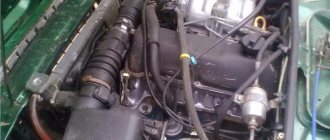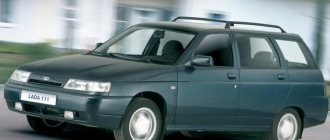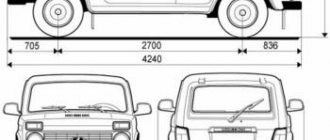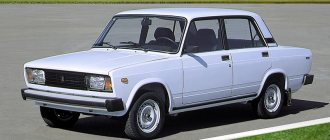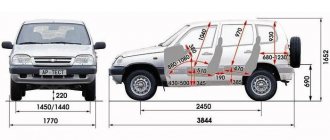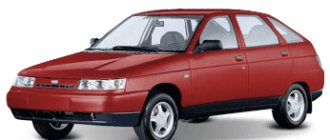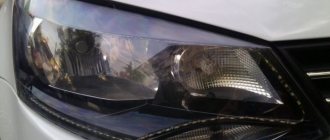Overall dimensions of VAZ-2110 cars, 2111, 2112
VAZ-2110 is a front-wheel drive passenger car with a transverse power unit, designed for use on paved roads.
The body is all-metal, monocoque, four-door, sedan type. To transport large and long cargo, the rear seat can be folded, thereby increasing the trunk volume.
Engines are four-cylinder, carburetor or with various fuel injection systems, with a displacement of 1.5 liters. Thanks to the front-wheel drive layout, the car has improved handling characteristics compared to rear-wheel drive VAZ models, especially on slippery roads and when cornering.
It is possible to equip the car with fog lights, heated front seats, electric windows, an on-board computer, a catalytic converter in the exhaust system, electric exterior mirrors, an electronic anti-theft system, air conditioning, anti-lock brakes, an airbag, and a sunroof.
The graphs show the dimensions of the VAZ 2112 car - width, length and height. Data is shown for all available modifications, including, for some, the overall width with mirrors.
The smallest cars are marked in green, and the largest in red.
Below is a summary table of overall dimensions for all modifications of the VAZ 2112.
On a VAZ 2112, the geometric dimensions of the body will definitely be needed by the owner who intends to independently correct or restore the parts. The situation on the roads has been extremely depressing lately. Due to the large number of vehicles, motorists are more likely to be involved in accidents, major and minor. The owners of “two-wheelers”, of whom there are a lot in Russia, are no exception in this regard. Find out from the article how the geometric dimensions of the VAZ 2112 body affect the ease of driving and which parts on this model are most quickly subject to deformation.
Body parts
The VAZ 2112 is popular among novice motorists. This is precisely what can explain certain shortcomings and deformations that appear on the car body elements over time. A novice driver is usually inexperienced and makes certain mistakes that lead to accidents or breakdowns.
Note. Bumpers suffer more often than others. These body elements are damaged during sudden braking or when the start is not timely enough, which leads to impacts from the front and rear.
Car wings are no less susceptible to deformation. These parts themselves are not very strong, and if they collide in a serious accident, they are severely deformed. Less serious damage can be corrected, according to the dimensions given by the standard geometry of the VAZ 2112 body. Complex deformations cannot be restored, and it is easier to replace.
Note. The front wings of the VAZ 2112 suffer most often, since these are the parts that break during side front impacts when the “twelve” does not give way.
And, of course, corrosion eats up a lot of parts of the VAZ 2112 if the owner does not take sufficient care of the vehicle. The hood, doors and those parts of the body that are either hidden from view or located close to the road surface are most often exposed to the negative effects of rye.
Getting to know the “twelve”
ATTENTION! A completely simple way to reduce fuel consumption has been found! Don't believe me? An auto mechanic with 15 years of experience also didn’t believe it until he tried it. And now he saves 35,000 rubles a year on gasoline!
The VAZ 2112 or “two-piece” car was produced, like its analogues, at the Volzhsky Automobile Plant. It is a 5-door hatchback body, reminiscent of the VAZ 2110 sedan in shape.
Production of the “twelve” began in the 99th year of the last century. The car body was copied from the VAZ 2110, but shortened to 4170 mm. The volume of the luggage compartment is 400 liters. Due to the shortening of the body, the car, compared to the “ten”, began to respond better to turning the steering wheel.
And in general, the model has a sportier character than the VAZ 2110. Combining all the advantages of the “ten”, the VAZ 2112 is also equipped with the rear seat of the 2111 station wagon.
The clear improvements over previous models are as follows:
- Despite the small length of the body, you can increase the small volume of the hatchback by transforming the rear seat;
- Better handling, especially when entering corners.
Like most VAZ models, the “dvenashka” was produced in several modifications and designs. In particular, we note the VAZ 21123 in the coupe body type. This modification even went through 3 body restylings and initially had a unique, original hood and bumper. Subsequently, the model was equipped with a grille and a standard hood.
Body features and the importance of geometric dimensions
In general, the “dvenashka” model is almost the most popular car in the domestic automobile industry, it is cheap and has a good design and a wide variety of body styles.
When developing this model, the manufacturer took into account many factors, including compliance with the individual tastes of each customer. In this regard, several body versions of the VAZ 2112 were produced, each of which had different targets.
Coupe, station wagon, sedan, hatchback - the “two-piece” was equipped with all these body types. The coupe is more correctly called a 3-door hatchback. This is the most rarely seen modification of the VAZ 2112. Its sporty design distinguishes it from other versions of the family, which are generally made quite monotonously.
Body repair VAZ 2112 coupeBody repair VAZ 2112 coupe
Experts believe that the VAZ 2112 coupe has the right to be called the best in terms of body design features and design. In total, about 10 thousand cars of this type were produced, after which production was discontinued.
Dimensions and dimensions also, along with the type of body structure, play a big role in convenience for passengers and good handling. Some modifications of the VAZ 2112 were even equipped with a sunroof, which increases the ease of use of the car.
So, here are the body dimensions of the VAZ 2112:
- Body – hatchback;
- Length, mm – 4170;
- Height, mm – 1435;
- Width without rear view mirrors, mm – 1680;
- Width with rear view mirrors, mm – 1875.
They, as we see from the table, better meet modern requirements and help the machine cope with a greater number of functions. The good spaciousness of the interior and trunk of the “two-wheeler” is a clear confirmation of this. Passengers feel very comfortable inside; the car can carry a lot of cargo if you are planning a long-distance family trip.
Geometric dimensions of openings
| For body 2111 | For body 2112 | For body 21123 |
| A – long diagonal of the rear side window frame – 780 mm | D – long diagonal of the rear side window frame – 710 mm | And – short diagonal of the front doorway – 1000 mm |
| B – short diagonal of the rear side window frame – 370 mm | E – short diagonal of the rear side window frame – 230 mm | K – long diagonal of the front doorway – 1500 mm |
| B – diagonal of the rear door opening – 1280 mm | F – diagonal of the rear door opening – 1320 mm | M – short diagonal of the rear side window frame – 720 mm |
| D – distance from the middle of the upper beam of the rear door opening to the middle of the lower beam of the opening – 925 mm | Z – distance from the middle of the upper beam of the rear door opening to the middle of the lower beam of the opening – 1050 mm | H – long diagonal of the rear side window frame – 1040 mm |
You can learn more about what the main body dimensions of the VAZ 2112 are from the table above and photo materials. In addition, valuable information about methods for measuring geometric diagonals can be gleaned from other instructions presented on our website.
Forget about fines from cameras! An absolutely legal new product - Traffic Police Camera Jammer, hides your license plates from the cameras that are installed in all cities. More details at the link.
- Absolutely legal (Article 12.2);
- Hides from photo and video recording;
- Suitable for all cars;
- Works through the cigarette lighter connector;
- Does not cause interference to radios and cell phones.
Tens body care and repairs
The overall body of the “ten” looks more reliable, durable and resistant to corrosion. All-metal and partially galvanized, it comes off the assembly line already treated with anticorrosive, ready for harsh operating conditions.
On the other hand, we must pay tribute to our car owners, who are accustomed to finishing everything with their own hands. In particular, while remaining adherents of the domestic automobile industry, they turn a blind eye to the differences and shortcomings of technology in comparative terms and take additional care of the body so that it serves for many years without problems. Russian car owners almost always add special protection to the standard anti-corrosion treatment.
Preventative work specifically involves tinting the bottom of the car, treating sills and fender liners with Movil.
Note. We can say with confidence that among the “dozens” with high mileage, even today you can find examples that have been so well cared for by the owner that they look like new.
People's love for the “ten” is also symbolized by the succinct names given to the car by amateurs. “Matryoshka”, “pregnant antelope”, “chubby” - all these nicknames, albeit with some degree of irony, speak of love for the car. If at first the unique, new design of the VAZ model raised questions, then over time the angular shapes of the “bow” and “stern” became familiar.
Here are the preventive works that are usually carried out on the body of the “tens” throughout the entire operational period:
- Caring for paintwork;
- Lubrication of metal components of the body;
- Cleaning of technical holes;
- Periodic anti-corrosion protection of the body as a whole and treatment of hidden areas;
- Noise insulation;
- Sealing.
To protect the original paintwork of the body, you must be able to select the appropriate polishes and follow the rules for their application. In addition, the VAZ 2110 must first be washed when the car is new, only with cold water, and for treating paintwork, use polishes that do not contain abrasives.
Caring for the paintwork of a car with a 3-5 year mileage implies a different scenario:
- Use products for weathered surfaces (they contain a certain amount of abrasive).
Accordingly, for a body older than 5 years:
- Use products specifically designed for aged surfaces.
It is also recommended to polish the body in small areas by hand using clean flannel. This is done to prevent the polish from drying out during application.
Polishes PMA-1 and PMA-2 have proven themselves well.
More good tips on the body in general:
- Do not store the car under rubber covers;
- Do not place rubber objects on painted surfaces (they will leave stains that are almost impossible to remove);
- Protect the paintwork from contact with alkalis, brake fluid and other chemicals that can destroy the coating.
It is recommended to lubricate rubbing parts and body elements from time to time in order to increase the durability of the metal frame. So, this should be done at least every 15 thousand km of the car or once a year.
Sport
Factory rally Lada 112 Super1600 class
Lada 21106 2.0 L participated in the 2008 FIA WTCC International Championship, where it was used by the Russian Bears Motorsport team, car No. 27 Ladygin Kirill[24], No. 28 Viktor Shapovalov and No. 29 Jaap van Lagen[25]. Since 2009, the team has acquired factory status. In 2010, the Lada Sport team stopped participating in the WTCC. In a VAZ 21103, as part of the LUKOIL Racing Team, the Italian Alberto Scilla won the Russian circuit racing championship in the Supertourism class in 2001 and 2002, and Alexey Dudukalo in 2003.
From 2004 to 2006, a modification of the VAZ 21106 - 27 took part in the RTCC as part of the Lada Racing factory team. The team's pilots were Alexey Gruzdev (No. 79) and Sergey Nuzhdin (No. 80).
From 2001 to 2003, the VAZ 21124-27 modification participated in the Russian Championship in automobile-circuit racing in the “Supertourism” class; also in 2003, modification 2112-37 became the main car of the circuit monoclass of the National Racing Series “Lada Cup”. Since 2004, a permanent participant in the National class and the Russian RTCC racing series.
Since 1999, VAZ-21106 has participated in the Russian Circuit Racing Championship in the Line 2000 class (Touring), as part of the Motorika Scientific and Technical Center and as part of the AvtoVAZ factory team (except for the 2003 season). from 2004 to 2006 in RTCC on modification 21106 - 27
Based on modification 21106, a racing version of the VAZ-21106-27 car was produced, which later became the VAZ-21107, and the Lada WTCC was also built. Since 2008, participant of the WTCC racing series.
Features of the piston group
The updated engine also received new pistons, in the bottom of which there are valve wells: four recesses 5.53 mm deep are made in each piston, which are designed to prevent bending (breakage) of the valves in the event of a timing belt break.
Previously, if this happened, the connection between the valves and the crankshaft was lost, their movement stopped, but the shaft itself, carried by the flywheel, continued to rotate by inertia, and accordingly, the pistons moved. As a result, they collided with the valves. The result is that they bend, break, or even pierce the bottom of the piston.
The dimensions of the piston rings, which can be either cast iron or steel, remain the same: 82 mm.
The piston pin has a floating fit, and its axial fixation is ensured by retaining rings. The length of the finger is 60.5 mm, and its diameter is 22 mm.
The 21124 engine connecting rods are interchangeable with the 2112 connecting rods.
VAZ-2110
Putting the “tenth” family into production line production cost VAZ quite a lot of money and effort. Due to the difficult economic situation, putting the “tenth” on the assembly line took a considerable time, although, according to the designers, the “tenth” model was ready for mass production already in 1992. The decision to put it into production was made twice, but for certain reasons adjustments were made to the design, and the decision had to be postponed. The first “ten”, which was properly processed by conveyor technology, was assembled on June 27, 1995, and the first production cars began to be produced only in 1996. “Ten” was perceived precisely as the first sign of better times. At least the VAZ workers themselves thought so.
The body, which is a four-door sedan, has received a completely new aerodynamic shape in a modern biodesign style. At least 50% of all car body parts were made of galvanized metal. The modern interior and design of the car, improved technical characteristics and a spacious interior fully met the requirements of the domestic passenger car market. In the “tenth” family there were only 4 body types: four-door sedan (2110); five-door hatchback (2112); a five-door utility station wagon (2111) and a four-door limousine (21109).
Initially, most of the cars were equipped with the already well-known engine of the previous VAZ-21083 model, but it was soon replaced by a new generation of engines that had electronic control and distributed injection of the fuel mixture. The “Ten” was equipped with 3 different engines with a volume of 1500 cc. cm: carburetor (2110) 72 hp; eight-valve injection (21102) with a power of 78 hp. (with a maximum speed of 170 km/h, and acceleration from 0-100 km/h in 14 seconds) and a sixteen-valve injection (21103) with a power of 91 hp. With. (with a maximum speed of 185 km/h and acceleration from 0 to “hundreds” in 12.4 seconds). Externally, 2110 and 21102 are no different. But model 21103 has differences: R14 size wheels, higher size front brakes and stiffer front wheel suspension springs. The more powerful model 21104 has the same characteristics (volume 1600 cc and power 96 hp at 138 Nm). Trunk volume – 430 liters.
Models of the “tenth” family were produced in 3 configuration options: “luxury”, “norm” and “standard”, which were designated “02”, “01” and “00”, respectively. For cars with an eight-valve engine, all 3 versions were provided, but for “sixteen-valve” engines - only “standard” and “luxury”.
Car engine
Engine type: L4 Engine location: front, transverse Supercharging: no Engine power, hp: 71 Achieved at rpm: 5600 Engine volume, cm3: 1499 Torque, N*m / rpm: 104 / 3400 Maximum speed, km/h :165Acceleration time to 100 km/h in sec.:14Recommended fuel:AI-95Fuel consumption (in the city), l/100 km:9.1Fuel consumption (out of town), l/100 km:5.5Fuel consumption (combined cycle), l/100 km: 7.6 Number of valves per cylinder: 2 Gas distribution system: overhead valve with overhead camshaft Power system: carburetor
Interior
If a person who drove a “tenth” model sits in a “two”, he will instantly find a fairly important difference. The gearbox housing is made of plastic and in the VAZ-2112 it is slightly larger
Because of this, from the right side of the edge of the brake pedal to the transmission tunnel-gearbox housing is approximately 9 centimeters. It turns out that within these 9 centimeters there should still be a gas pedal.
It is clear that pressing such pedals is not so convenient, because together with the accelerator pedal you can press the brake in the reverse order. The steering wheel is exactly the same as in regular “tenth” models. The cars received an adjustable steering wheel. As for the seats and door panels of the twelfth model, they were covered with fabric in the same color as the vehicle body itself.
Due to the wing mounted on the luggage compartment lid, the level of visibility drops significantly. Some car owners decide to dismantle it, also justifying it by the fact that this improves the appearance of the Lada 2112. The glove compartment, located in the “two-piece” in front of the front passenger, turned out to be quite spacious and can accommodate A4 sheets.
Speaking of the front panel, it reminds some of the familiar lowest torpedo from the early releases of the G8. Engineers were able to create a convenient instrument cluster. Of course, there are some inconveniently located control buttons, but the torpedo itself as a whole is not as bad as it might seem.
It’s worth being frank: the twelfth model has hard plastic that often produces creaking sounds, but it is clear that it is much more ergonomic than the “eighth” family. In the center you can see the famous signaling device with a drawing of a car, informing the driver that not all doors are closed. On the side there is a clock, an emergency signal button, which could have been made a little larger, as well as adjustments for the stove and damper.
In general, sitting at the helm of the Lada-2112 is quite free. However, the steering wheel covers the buttons for lights, fog lights and heated glass. The switches are conveniently located under the steering wheel, so there is no need to reach them. The steering wheel is precisely adjusted in thickness, so it is convenient to use. I would especially like to thank the engineering staff for installing height-adjustable seat belts.
There is enough free space at the feet of the person sitting in front. The factory decided not to spoil the door trim in any way, so it evokes more pleasant emotions than, for example, the hard plastic of the Lada Priora. The presence of a pleasant, fleecy upholstery material and a convenient pocket at the bottom will only please the driver. The rear end can no longer please so much. A passenger sitting on the back sofa of a VAZ 2112 will slightly touch the front seat, but the sofa itself is quite comfortable.
It is two-part (the back is divided into 2 parts). It was “transferred” to the twelfth model from 2111. This made it easier to transport luggage. The average person doesn't hit the ceiling with their head. Inspecting the ceiling upholstery, you can notice a rather interesting element. The black plastic box has a sensor that sets the optimal temperature inside the car.
It cannot be said that the luggage compartment of the VAZ 2112 is very large, but it is not small either, as for this class. For the driver, 399 liters are provided. But if necessary, this figure can be increased by folding the back of the “gallery” in parts in a ratio of 2:1, which already provides a volume of up to 730 liters of usable space.
The hatchback's underground raised floor has a standard set - a full-fledged spare wheel and the necessary tools. You can also notice a small shelf for light items on top. Speakers were placed near the rear windows. Another difference from the 8th family of cars is the low loading height, which makes loading/unloading luggage much easier.
Ignition system
The VAZ 21124 16-valve engine is equipped with an ignition system consisting of NGK BCPR6ES or AU17DVRM spark plugs, a knock sensor and individual ignition coils. The latter are the third innovation in the design of the motor and improve its dynamic characteristics.
Engine control unit and its sensors.
This part is the “brain” of the power unit. It provides all the technical characteristics of the VAZ 21124 engine declared by the manufacturer. The block is designed to coordinate and synchronize the work of all subsystems. It receives information about the current state of the motor using sensors:
- Crankshaft position and speed.
- Mass air flow (MAF).
- Coolant temperature.
- Camshaft positions.
- Detonations.
- Throttle valve positions.
- Double lambda probe, which determines the amount of oxygen in the exhaust gases, installed before and after the converter.
- Rough road sensor.
The described engine is equipped with an ECU 21124 with a BOSCH M 7.9.7 controller, ensuring compliance with Euro 2 and 3 environmental standards.
Car weight VAZ-2112
The VAZ automobile concern regularly delighted car enthusiasts with new models, starting in the 60s of the last century. Each new car featured unique additions and improvements. Even the weight of the car increased from brand to brand due to additional modifications.
The total weight of the VAZ-2112 is 1060 kg. On average, the weight of the main components does not differ much between models. So:
- engine weight of model 2112 with a volume of 1.5 liters - 126 kg;
- gearbox weight – 27 kg;
- the radiator weighs 8 kg;
- the weight of the bare body of the VAZ-2112 is 290 kg.
The engine is considered an important unchanged part of a VAZ car; of course, over time it has undergone new modifications, but the basic basis has always been model 21083. While maintaining the basic parameters, the developers increased the power and service life of the engine in subsequent models
The engine began to save fuel significantly, but there remained a lack of torque at low speeds. The rollers and belt drive are also unreliable, and if the timing belt breaks, there is a high probability of bending the valves.
Specifications
| Model | VAZ 2112 | VAZ 21121 | VAZ 21122 |
| Body type | hatchback | hatchback | hatchback |
| Number of seats | 5 | 5 | 5 |
| Number of doors | 5 | 5 | 5 |
| Trunk volume, (dm3) | 400 | 400 | 400 |
| Car dimensions: | |||
| — length, (mm) | 4170 | 4170 | 4170 |
| — width without mirrors, (mm) | 1680 | 1680 | 1680 |
| — height, (mm) | 1435 | 1435 | 1435 |
| Own weight, (kg) | 1010 | 1010 | 1010 |
| Payload, (kg) | 475 | 475 | 475 |
| Base, (mm) | 2492 | 2492 | 2492 |
| Front track, (mm) | 1400 | 1400 | 1400 |
| Rear track, (mm) | 1370 | 1370 | 1370 |
| Ground clearance to engine oil pan, (mm) | 165 | 165 | 165 |
| Ground clearance to the lowest point of the exhaust system, (mm) | 140 | 140 | 140 |
| Device Features: | |||
| Engine | 2112 | 2110 | 2111 |
| Tires | 13″ or 14″ | 13″ or 14″ | 13″ or 14″ |
| Drive wheels | front | front | front |
| Steering | rack and pinion | rack and pinion | rack and pinion |
| Front suspension | McPherson | McPherson | McPherson |
| Rear suspension | trailing arm | trailing arm | trailing arm |
| Number of gear stages | 5 | 5 | 5 |
| Gearbox ratios: | |||
| 1st gear | 3,636 | 3,636 | 3,636 |
| 2nd gear | 1,95 | 1,95 | 1,95 |
| III gear | 1,357 | 1,357 | 1,357 |
| IV gear | 0,941 | 0,941 | 0,941 |
| V gear | 0,784 | 0,784 | 0,784 |
| Reverse | 3,5 | 3,5 | 3,5 |
| Front brakes | disk | disk | disk |
| Rear brakes | drums | drums | drums |
| Parking brake drive | cable | cable | cable |
| Clutch drive | cable | cable | cable |
| Dynamic and operational characteristics: | |||
| Maximum speed with full load, (km/h) | 185 | 185 | 185 |
| Acceleration time to 100 km/h with full load, (s) | 12,5 | 12,5 | 12,5 |
| Minimum turning radius, (m) | 5,2 | 5,2 | 5,2 |
| Maximum lift without acceleration | 34° | 34° | 34° |
| Braking distance loaded from 80 km/h, (m) | 38 | 38 | 38 |
| Fuel consumption at 90 km/h, (liters per 100 km) | 5 | 5 | 5 |
| Fuel consumption at 120 km/h, (liters per 100 km) | 6,3 | 6,3 | 6,3 |
| Fuel consumption in the urban cycle, (liters per 100 km) | 8,8 | 8,8 | 8,8 |
| Fuel tank capacity, (l) | 43 | 43 | 43 |
| Weight of towed trailer with brakes, (kg) | 800 | 800 | 800 |
| Weight of towed trailer without brakes, (kg) | 400 | 400 | 400 |
| Cx (drag coefficient) | 0,3 | 0,3 | 0,3 |
| Noise level in the cabin at 100 km/h, (dB) | no more than 72 | no more than 72 | no more than 72 |
Why does the fuel pump on the VAZ-2112 injector 16 valves not pump and not work?
Technical characteristics of VAZ-2112-37
| Engine | VAZ-2112 |
| Working volume | 1500 cc cm |
| Number of valves | 16 |
| Control system | "January 5.1" with changed calibrations |
| Exhaust system | direct flow, with 4-2-1 manifold |
| Maximum power | 100 hp at 5800 rpm |
| Maximum | 135 Nm |
| torque | at 5000 rpm |
| Clutch | Sachs |
| Transmission | VAZ-2112-69, reinforced |
| Gear ratios | |
| I | 2,92 |
| II | 2,05 |
| III | 1,55 |
| IV | 1,31 |
| V | 1,13 |
| Main couple | 4,1—4,7 |
| Suspension | |
| Springs | special sports |
| Shock absorbers | VAZ-2112-27, gas-filled |
| Anti-roll bar | reinforced (21 mm) |
| sustainability | |
| Stretch Brackets | steel, reinforced |
| Brake system | |
| Front brakes | AP Racing, disc, ventilated |
| Rear brakes | AP Racing, disc |
| Brake force regulator | AP-Racing |
| Tires | Michelin 18/58—15* |
| Seats | Sparco |
| Steering wheel | Sparco |
| Belts | Sabelt |
| Fire extinguishing system | Sparco |
| Curb weight | 910 kg |
| * Option for asphalt rallies. | |
| Measurement results | |
| Maximum speed, km/h | 147,5 |
| Acceleration time, s | |
| 0—50 km/h | 3,05 |
| 0—100 km/h | 8,78 |
| on the way 400 m | 16,69 |
| on the way 1000 m | 31,77 |
| 60-100 km/h (III) | 5,20 |
| 60-100 km/h (IV) | 7,94 |
| 80-120 km/h (V) | 8,95 |
| Run-out, m | |
| from 50 km/h | 307 |
| 130—80 km/h | 634 |
Modifications
- VAZ-21120 - with a 16-valve engine with distributed fuel injection, displacement 1.5 liters. 14 inch wheels.
- VAZ-2112-37 is a racing model of the VAZ-2112, prepared for the “ring” in the Lada Cup qualifying group. Engine VAZ-2112, 1.5 l, 74 kW/100 l. s., Hatchback body, number of doors – 5, number of seats – 1, equipped with a safety cage, external aerodynamic kit, front extension of the strut support cups.
- VAZ-21122 - with an 8-valve engine with distributed fuel injection, displacement 1.5 liters, 13-inch wheels.
- VAZ-211223 is a three-door hatchback of the VAZ-2110 (“coupe”) family.
Tuning
Now we come to the most interesting part. After all, almost every modern driver wants to tune the VAZ 2112 engine. This allows not only to increase power, but also efficiency.
- The first thing you can do is chip tuning the unit. In essence, this is a simple firmware of the brain, which is very interesting. Almost every driver can do it.
- You can also replace the camshaft and bore the valves. This tuning of the VAZ 2112 engine is very common not only in Russia, but also abroad.
- If you want to increase the turbo of the VAZ 2112, then you should install a special compressor. It has only one drawback: the power unit heats up very much. Because of this, it is necessary to install a high-quality cooling system. Tuning also allows you to get rid of the car’s tripping.
- Experts recommend installing only one compressor. After all, if you install a little more, more power will be supplied, and accordingly the unit will heat up even more.
- If you want more power, you can install a throttle. This method allows you to improve the response of the gas pedal and normalize the operation of the power unit. You don't have to attach all sorts of turbo systems, which is very good. This method is based on installing a throttle in each cylinder. Agree, a very good idea for a domestic car.
- It is worth noting that almost all drivers want to increase the turbo of their iron horse. To do this, install a special supercharger that increases power.

